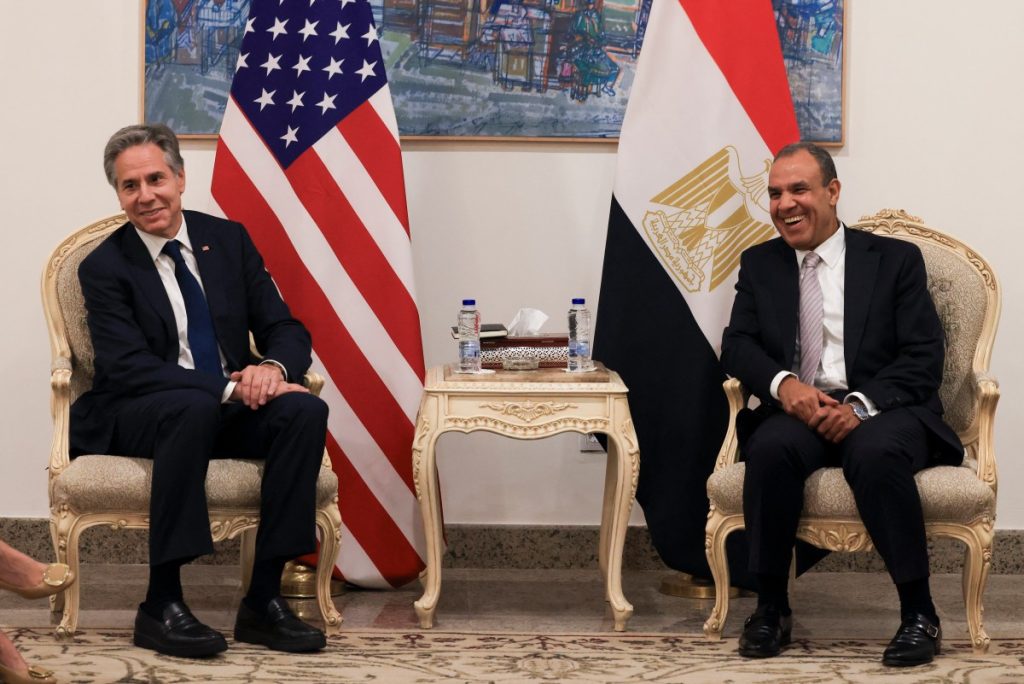Top US diplomat Antony Blinken was in Egypt on Tuesday for discussions on a ceasefire in Gaza, following Israel’s acceptance of a US “bridging proposal” for an agreement. Blinken also urged Hamas to agree to the proposal. On his ninth visit to the Middle East, since the Palestinian resistance group’s attack on October 7 sparked the current conflict with Israel, Blinken flew to El Alamein, a Mediterranean city known for its World War II battle.
There, he began talks with Egyptian President Abdel Fattah al-Sisi at his summer residence.
Following his visit to Egypt, Blinken is set to meet with Qatar’s Emir, Sheikh Tamim bin Hamad Al-Thani, in Doha, where ceasefire discussions took place last week.
US Secretary of State Antony Blinken‘s visit to the Middle East is a significant diplomatic event that underscores the United States’ commitment to addressing regional issues and fostering stability.
Here are some things to note from Anthony Blinken’s visit to the Middle East.
Addressing the Israel-Palestine Conflict:
One of the key focuses of Blinken’s trip was the ongoing Israeli-Palestinian war. The US Secretary of State participated in in-depth conversations with Israeli officials and Palestinian representatives to consider ways to reinvigorate peace negotiations and tackle humanitarian issues. Blinken stressed the US’s backing for a two-state solution and urged actions to diminish tensions and enhance conditions on the ground. His visit aimed to show the US’s dedication to facilitating discussions and furthering endeavours toward a sustainable resolution to the conflict.
Strengthening Alliances and Partnerships:
During his trip, Blinken’s main focus was on strengthening current alliances and partnerships with Middle Eastern nation. This included not only reaffirming the US’s dedication to its long-term allies like Israel and Saudi Arabia, but also working to establish new connections and enhance collaboration with other key players in the region. The visit underscored the vital strategic significance of these partnerships in addressing regional threats, particularly from Iran and extremist organisations. By directly engaging with leaders and tackling their concerns, Blinken sought to cement these partnerships and ensure a unified approach to regional challenges.
Countering Iranian Influence:
A key part of Blinken’s visit involved addressing Iranian influence in the region. The US expressed concerns over Iran’s support for militant groups and its nuclear ambitions. Blinken’s meetings with regional leaders was aimed at developing strategies to counteract Iran’s influence through enhanced security cooperation and coordinated policies, highlighting the need for a unified approach between the US and Middle Eastern countries.
Promoting Regional Economic Development:
During Blinken’s visit, discussions on economic development and regional stability took place. The US aims to promote economic growth to foster stability and prevent conflicts by enhancing trade, investment, and economic cooperation among Middle Eastern countries, supporting infrastructure projects, and encouraging private sector involvement. Through economic development, the US seeks to address the root causes of instability and create a more prosperous environment in the region.
Humanitarian and Human Rights Concerns:
During his visit, Secretary of State, Blinken addressed humanitarian issues, promoted human rights, and discussed ongoing crises in Yemen and Syria. He emphasised the need for increased international support and aid, and urged regional governments to improve human rights conditions, better treatment of refugees, and alleviate humanitarian suffering.
Antony Blinken’s visit to the Middle East addressed strategic alliances, the Israeli-Palestinian war, Iran’s influence, economic development, and humanitarian concerns. His engagement with regional leaders and focus on these key issues reflect the US’s broader strategy of promoting stability and fostering cooperation in the region.

